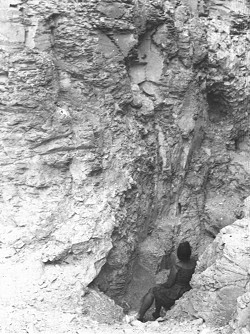
The term used for the places where several mummies of kings or priests were concealed to protect them from tomb robbers. The term is also used for the pit at Karnak where used temple equipment was buried.
When the residence was transferred to the Delta in the period from the 19th - 21st Dynasties, the Theban necropolis became a target for tomb robbers. The high priest Pinedjem I decided to protect at least the royal mummies; he removed them from their tombs, often already robbed, gathered them together and wrote their names on them. After the mummies had been moved to various places, some of them found peace at last in the generation after Pinedjem, until they were rediscovered in 1875 by Egyptian people. They kept the find a secret, and began to sell parts of it. In 1881, Maspero discovered that a group of 40 sarcophagi with the mummies of priestly and royal families from the 17th and 18th Dynasties, including Ahmose I, Amenhotep I, Thutmosis I-III, Sethos I and Ramesses I and II, had been secretly gathered together into the tomb of a wife of Ahmose I, Inhapi (11th Dynasty) at Deir el-Bahari, together with a list of tomb contents. The tomb of Amenhotep II was a similar hiding place, where Loret also found Thutmosis IV, Amenhotep III, Merenptah and Sethos II.
In an attempt to outwit the tomb robbers, the priests from the 21st and 22nd Dynasties were also put into communal tombs. Nine shafts with 60 mummies in their sarcophagi were found in a rock temple above the temple of Assasif, and during work on the temple of Deir el-Bahari, Mariette found 71 sarcophagi belonging to priests of Montu. The largest find was made by Georges Daressy in 1891 - he found 153 sarcophagi, 101 of them double sarcophagi, in the tomb of the high priest Ramenkheper at Deir el-Bahari.
At Karnak a pit was discovered where priests had buried statues from the temple of Amun. There were about 800 large and small statues of members of the royal family, gods and private persons. They also found 17,000 smaller objects, including many statuettes of Osiris. The objects, which mainly date to the period of the New Kingdom down to the 2nd century BC, were probably buried after one of the regular 'tidying' sessions of the increasingly full temple.